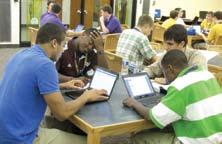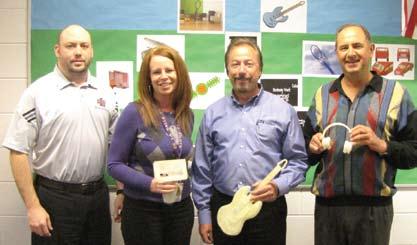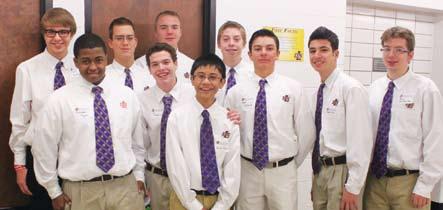
6 minute read
Conversation with Patrick R. Adams Jr
A Conversation with...
Technology upgrades include increased broadband capacity and 90 tablet computers
When you came to De La Salle in 2005, where was the school in terms of technology?
When I first got here, the first thing I noticed was Chris Dean (Assistant Principal) walking around picking up attendance slips from classroom doors. We administrators joke about it now, but I couldn’t believe we were still doing that.
Since then, we’ve moved forward in technology by leaps and bounds.
Initially, what did you do with technology?
We started to make a plan. We had to have enough infrastructure for all of the teachers and administrative staff to make use of technology.
In my first five years, we instituted wireless in the building. We put Smart Boards in every classroom. We issued every teacher a laptop. We developed an online system for grades, attendance, and communicating with parents. Eventually, we evolved to teacher web pages.
And slowly but surely we have looked at student use, primarily in the library/ media center, which we now call the Digital Resource Center (DRC).
Besides the name change to DRC, how has the library changed over the past seven years?
When I came here, there were six computers in the corner, in study carrels for student use. Now we have 42 computers in there, along with 30 Google Chromebooks (tablet computers).
We took the two rooms adjacent to the librarian’s office, cleaned them out, knocked out one of the walls, and made one room a computer area The other room is now where our Information Technology (IT) people are. It’s much better for our IT Director Dennis Parks to be right there, along with his assistant Mrs. Sheryl Anderson, to assist with any computer issues that may arise in the DRC.
You’ve established a Technology Leadership Team. What do they do?
We’re not fundamentally different from any other school or business in that the rate of change in technology is so rapid that any big institution is always going to be behind the curve. How you deal with that is really the mark of how successful you’ll be as an institution.
What our tech team does is look at issues and figure out how we’re going to acclimate. One of the things we’ve done is to say that as a teaching staff, we’re going to allow interpersonal devices - laptops, tablets, smart phones. A lot of our teachers have been using computers nearly their entire lives, and certainly throughout their college careers.
The team has also looked at increasing our connectivity and speed. Over the summer, we increased our broadband capacity to be nine times greater, provided a bigger “pipe.” We had teachers using laptops and the Smart Boards, on the internet, and then trying to get a YouTube clip up on the Smart Board. They needed that greater speed so the Students in the Digital Resource Center – using Chromebook tablets.
whole thing wouldn’t freeze when you had multiple people online.
We also allocated funds in the budget to increase the wireless capacity in the library to accommodate all those computers and tablets, as well as in one wing where we have two teachers teaching the freshman seminar using Google Chromebooks.
What’s the tech team looking at for the 2013 - 2014 school year?
We meet every other week, a standing meeting, to talk about future issues and budget. Our conversation has centered on where to increase the wireless capacity, and we’re looking at the Commons and the Cafeteria. It makes sense that there should be more wireless availability in those areas where students congregate.
We’re also looking at a third set of Google Chromebooks for the freshmen. Right now we have two teachers, each with 30 Chromebooks. We’re looking to put a third teacher in that wing.
Why Chromebooks with the freshmen?
A couple of years ago, we decided to offer our Freshmen the “Career Forward” program through Michigan Virtual University to satisfy the State of Michigan requirement for at least
Principal Patrick Adams
one credit to be earned through an online course. It’s much better to have all the students at the same point to enable better teacher collaboration. What we’re really fostering is having all of our students keep up with the curve.
How are teachers using technology? And how do you train them?
Besides the posting of attendance and grades and emailing with parents, teachers have developed web pages and prepare lessons integrating the Smart Board. They are collaborating as departments using Google Docs. And they’re using Google Docs with their students in class so they are seeing work in real time.
Teacher training has been a longstanding issue. The tech leadership team needs to develop a professional development plan that is systemic for novices, intermediates, and experts. We systematically train teachers to keep up with the kids. How to use Google Docs in class. How to use Smart Boards. And we look at how best to use our experts. Do we have them double back and make them trainers or is that too much work for them? Do we send them off on extensive research? Some of our teachers are really good at using technology and integrating it into their teaching.
All the technology costs money. How are you addressing the budgetary issues?
The third thing the tech team has been working on, besides the wireless issue and the teacher training plan, is on our tech plan for accreditation from the North Central Association. We’re also doing the tech plan for the State of Michigan so we can make some grant applications. Without a plan, you can’t get a grant.
The kids are pretty comfortable with technology. The teachers are using Smart Boards and Google Docs. How about the administration?
We use the PD360 app on the Ipad. PD360 is a professional development program. We have an agreed upon template or rubric, so that when each of the four administrators - myself, Steve Stewart, Chris Dean, Brian Kelly - go into a classroom, and observe, we make notes and send it to the teacher right then.
At first, teachers found it a little intimidating. Any change is difficult. Someone is in their classroom and taking notes and sending them immediate feedback. In the end, it makes professionals better so that they can serve kids better. The most important thing is to follow up any online communication with a face to face conversation. That is the means to facilitate real learning and growth.
How about Ebooks? Is the day coming when every student will carry around his own laptop or tablet?
I think that depends on what publishers are going to do. They have not opened the floodgates, and are trying to address their own revenue stream. There are very few textbooks available as Ebooks right now. Once you can have all your books downloaded, there’s a much greater chance of everyone having to have a laptop or tablet. Without those Ebooks though, the backpack still lives.

Thanks to the donation of a server from RAVE Computers, students in the Advanced Engineering classes are now able to use the latest version of Dassault Systems’ CATIA software, V6, used in industry for Computer Aided Design (CAD). With the 25 comptuers purchased from RAVE, students work on CATIA projects in “the Cloud.” Photo (L. to R.): Dennis Parks (DLS Information Technology Manager), Sharlene Kroneck (Advanced Engineering teacher), Tony Scicluna, ’74 (Vice President of Sales at RAVE Computers), and Rick Darter (CEO and President of RAVE Computers). Sharlene, Tony, and Rick are holding plastic models of student-designed projects, “printed” using a 3-D printer at Proper Tooling, thanks to Mark Rusch, ‘75.








